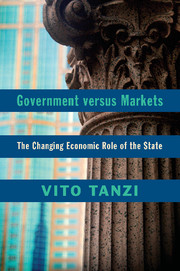Book contents
- Frontmatter
- Contents
- Preface
- PART ONE THE ECONOMIC ROLE OF THE STATE
- PART TWO HISTORICAL REVIEW
- PART THREE THEORETICAL AND ANALYTICAL ISSUES
- PART FOUR THE OUTCOME OF STATE INTERVENTION
- 11 Evaluating the Impact of Public Spending on Socioeconomic Indicators
- 12 Social Protection in the Modern World
- 13 The Role of the State and Economic Performance in the Nordic Countries
- PART FIVE ON THE ECONOMIC ROLE OF THE STATE IN THE FUTURE
- Notes
- Index
- References
13 - The Role of the State and Economic Performance in the Nordic Countries
Published online by Cambridge University Press: 07 October 2011
- Frontmatter
- Contents
- Preface
- PART ONE THE ECONOMIC ROLE OF THE STATE
- PART TWO HISTORICAL REVIEW
- PART THREE THEORETICAL AND ANALYTICAL ISSUES
- PART FOUR THE OUTCOME OF STATE INTERVENTION
- 11 Evaluating the Impact of Public Spending on Socioeconomic Indicators
- 12 Social Protection in the Modern World
- 13 The Role of the State and Economic Performance in the Nordic Countries
- PART FIVE ON THE ECONOMIC ROLE OF THE STATE IN THE FUTURE
- Notes
- Index
- References
Summary
Introduction
Those who have strong preferences for a large economic role of the state often point to the Nordic countries of Europe as examples of mature welfare states that prove that high public spending and high tax levels, combined with wide social protection, can coexist with good economic performance. In recent decades, the Nordic countries have had the highest levels of public spending in the world, the highest tax levels, the lowest Gini coefficients, and the lowest poverty rates. They have the most effective safety nets among countries while managing to retain very favorable rankings in countries' competitiveness leagues, such as those prepared by the World Bank, on “The Ease of Doing Business”; in “economic freedom” indexes, prepared by the Heritage Foundation and the Wall Street Journal; and in the “Corruption Perception Index,” prepared by Transparency Internationals. According to the April 16, 2010, special edition of Forbes, these countries even included 17 of the world billionaires. In the 2010 rankings on the Index of Economic Freedom, Denmark ranked 9th, Finland ranked 17th, and Sweden ranked 21st out of 122 countries.
The Nordic countries seem to defy the notion that large public spending and the high tax levels that it requires are necessarily damaging to the economic performance of countries and to the economic freedom of individuals. The inevitable question that arises is, If this is true for these countries, why should it not be true for other countries?
- Type
- Chapter
- Information
- Government versus MarketsThe Changing Economic Role of the State, pp. 267 - 302Publisher: Cambridge University PressPrint publication year: 2011

